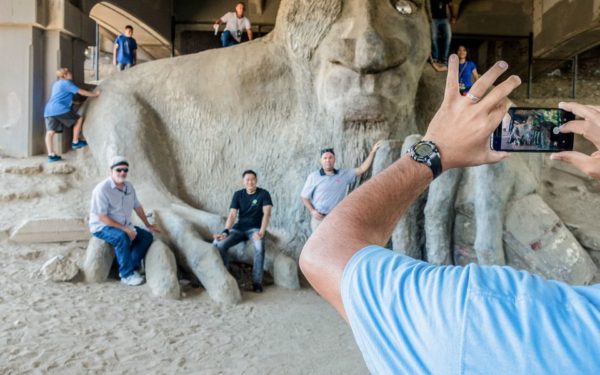The past year has proven to be quite a ride when it comes to the job market.
Employee turnover seems to be the next epidemic, in that people have been leaving their jobs in record numbers for over a year now. The most concerning part is that they’re quitting voluntarily.
But why?
“The Great Resignation” reportedly began in April 2021 when 4 million Americans quit their jobs. By early August, 65% of US workers were actively job-hunting, while only 35% of Fortune 1000 company CEOs had started prioritizing employee retention. Now… we’re not mathematical geniuses but that’s clearly quite a deficit!
The best defense is a good offense so addressing high turnover rates is not something you want to do AFTER there is a problem. Getting ahead of the issues and developing effective retention strategies is far more beneficial (and less expensive) than the alternative. Keeping those top performers on your roster is an invaluable resource that pays off for years to come.
Not sure where to start? We’ve dug deep and identified 21 super-effective ways to help you reduce turnover at your company.
Why is it important to reduce employee turnover at your organization?
It’s important to reduce turnover in every aspect of your business. Lack of retention impacts more than just the bottom line. High employee turnover rates are costly on all fronts, not just financially. Here are a few examples of some positive ways that improving your employee retention efforts impacts your organization.
1 – Improved Employee Satisfaction
This may sound a little “soft” but the hard fact is, satisfied employees stay where they’re happy.
2 – Keep the Experienced and Knowledgeable Employees
Holding on to the institutional knowledge your most experienced employees bring to the table is an invaluable investment in their long-term success and that of your company.
3 – Cost Implications
Onboarding is a costly process and having to do it repeatedly is an expense you can’t really afford.
4 – Positive Company Culture
Fostering a healthy, happy, and positive work environment creates a sense of belonging for employees, making it harder for them to leave when opportunities arise.
5 – Increased Profits
Happy employees (see Reason 1 above) are more motivated, empowered, and productive, which all calculates to a more profitable bottom line.
How To Reduce Employee Turnover At Your Business
1 Make a good first impression with new hires
“You never get a second chance to make a first impression.”
New employees know within the first six months whether they’re going to stay, so launching their new career with a thoughtful welcome kit is a great kickstarter. Making welcome kits a staple in your onboarding process can increase retention rates by up to 25%.
Tip: You can create your employee welcome kit program so that once new hires are onboarded, they’ll receive their very own welcome kit automatically shipped to them!
2 Celebrate employee milestones
While milestones certainly aren’t the only reason to celebrate your employees, they are a pretty big deal in the grand scheme of things. Your employees are investing their time and valuable energy into the success of your company and deserve recognition for such.
Promotions, work anniversaries, personal accomplishments or life changes, educational completions… all very notable occasions worth celebrating.
Tip: Check into some of the super simple tracking software available for keeping tabs on these important milestones. It’ll show your employees their efforts are appreciated and their happiness (in and out of work) matters.
3 Offer competitive compensation at each level of your company
Truth is… money talks. Compensation is at the top of the list when job-seekers are weighing their employment options but it’s not always about the actual take-home pay. Offering a competitive compensation package is more than just a salary. Considering the benefits, perks, and extras helps create the best package options for your new hires.
Tip: Comparing your company’s compensation package against similar businesses in the market can help ensure you’re offering new employees an enticing and competitive rate and benefits bundle.
4 Establish a culture where employees are recognized

Courtesy of Nectar
Employee recognition is more than just the latest buzzword in business. A recognition-rich culture makes employees aware of their importance to the organization. With so many software platforms available now, rewarding employees isn’t an expensive and daunting task.
And since recognized employees tend to stay where they’re appreciated, this bodes well for your retention rates.
Tip: You can send rewards directly to employees with a recognition platform like Nectar!
5 Encourage managers to communicate and avoid micromanaging
Micromanaging is among the top three reasons people list for leaving a job. Determining the balance between everyday duties and future thinking is imperative to creating a healthy culture of trusted and fully capable employees.
Additionally, micromanaging can lead to burnout and added stress on both ends of the transaction, which ultimately increases turnover.
Tip: Leadership styles can vary dramatically. Offering training on effective communication in the workplace or courses on mastering the art of delegation can help balance the scales.
6 Invest in your onboarding process and make sure it is streamlined and effective
A poorly designed onboarding process can make a really bad impression on new hires. It sets the tone for their expectations of your organization and is a major factor in their overall employee experience. It could even push them to start looking elsewhere far sooner than if they’d had a positive onboarding experience.
Tip: Audit your current onboarding process and identify the weak spots. Making a few small improvements could make a big difference in helping you to onboard new employees effectively and efficiently. You can even work with an HR outsourcing service (like Bambee) that can help to streamline several human resource responsibilities and tasks.
7 Mentor employees and set up processes for additional training and development
Training and career development programs are an investment in your employees. These opportunities carry a lot of weight when it comes to deciding to stay with or leave a company. Arming employees with all the tools they need to be successful is beneficial to them and their intended career path, as well as to the business.
Tip: Find out your employees’ career goals and aspirations. Then offer ways to help them grow and thrive so they can crush those goals and continue to progress in the organization.
8 Create opportunities for employees to get to know each other outside of work
Creating opportunities for social interactions allows employees to engage on a more personal level without the cloud of work hovering over them. Studies show that interpersonal relationships in the workplace are a major factor when it comes to employee happiness.
Having friends at work strengthens our social ties and creates bonds with coworkers that essentially contribute to a reduction in employee turnover.
Tip: These opportunities to socialize help everyone see their coworkers in another light and find out what feeds their passions. Schedule recurring team lunches, plan a bowling night, or coordinate a scavenger hunt to get everyone out of the office and out of the workplace mindset.
9 Schedule regular team building events and mixers

Courtesy of Outback Team Building
Team building activities are a great way to improve collaboration and communication among coworkers. They also build trust, help with conflict resolution, and encourage effective communication. These events forge a sense of community and support a cohesive team mentality, increasing employee satisfaction and decreasing employee turnover.
Tip: You can book a team-building activity with a professional service like Outback Team Building which will plan and manage the entire event from start to finish.
10 Reward employees with non-monetary incentives
Yes… we already stated that “money talks” but don’t sleep on the value of non-cash perks! Non-monetary incentives can include anything from training and development opportunities or a more flexible work schedule to public recognition and experiential rewards.
Non-monetary incentives pack a punch when it comes to showing appreciation to employees and they resonate just as strongly (if not more) as those with a dollar value.
Tip: Design your custom non-monetary incentive program or partner with a recognition platform like Bonusly to help make recognition a part of everyone’s day, every day.

Courtesy of Bonusly
11 Provide HR with enough support and resources
HR professionals handle far more than just hirings and firings. There are benefits to coordinate, training to schedule, policies to review, conflicts to resolve, payroll to approve, safety measures to implement, and performance evaluations to conduct… just to name a few.
Ensuring your human resource management team has the support and HR tools they need to do all these jobs well and promptly, not only keeps them from burning out, but also greatly benefits the employees who rely on them as a company resource.
Tip: You can even use a trusted HR service to provide additional HR support to your employees, regardless of how large your company is or the number of employees you have.
12 Allow current employees to interview for promotions and open positions
Statistically, people stay with a company 41% longer when their organization prioritizes internal hiring and advancement. Allowing your (already trained, already loyal) employees to pursue these opportunities, motivates them to strive harder to get to where they want to be.
This is an investment in them that pays off for your business. You’ll be able to retain those skilled and experienced team members who, meanwhile, are becoming more and more vested in the organization themselves.
Tip: Offering your current employees specialized training and development options helps to upskill them so they’re ready for their next big opportunity when it arises. Giving them first dibs on all new positions and opportunities before accepting any outside resumes will drive a deeper commitment from your team members and help retain your most skilled and knowledgeable employees.
13 Communicate larger company goals, news, and updates with the entire staff
There’s a lot of truth in the statement “trust happens when leaders are transparent, ” which certainly applies to business. Employees want to see the big picture regarding the company they’re supporting. Good, bad, or ugly, they appreciate being in the know and even more so, appreciate a leadership team who values the same.
Tip: Whether you hold town hall meetings, global team Zoom calls, or one-on-one discussions, keeping the whole company in the loop makes employees feel like they’re a part of something bigger.
14 Offer an incentive of paid time off
Incentives offer employees a hard target with a reward at the finish line. Reaching specified goals and milestones and being rewarded with paid time off is a great morale booster. Using extra days off as an incentive increases productivity and improves employee loyalty.
Tip: This incentive will have them working harder to earn those Summer Fridays off so make the targets challenging but realistic for your team.
15 Provide raises to current employees
Maintaining employees’ growth once they’re on board is just as important for retaining top talents as offering a great starting pay to attract them. Employees who aren’t provided growth opportunities – both professionally and financially – are far more likely to start window shopping for a better job option.
Raises show your current employees that you notice their hard work and they’re appreciated for their contributions.
Tip: Peep the competition. Gathering a little recon about how often your competitors are issuing wage increases and what percentages they’re giving helps keep your business on top of the market trends.
16 Set up offboarding and exit interviews with departing employees
You can’t exactly pivot to a better approach if you don’t know why people are leaving. Understanding the “why” behind your turnover numbers can help to identify where you need to make some adjustments in your processes and employee relations. Soliciting this kind of valuable employee feedback probably won’t be fun to hear but it’s absolutely necessary to foster a healthy company culture.
Tip: Make exit interviews a staple in your offboarding process and give your departing employees the opportunity to provide constructive feedback on why they decided to move on.
17 Invest in DEI
Repeatedly replacing valuable employees for reasons like harassment, inequality, or discrimination in the workplace isn’t just costly to your retention rates. A lack of diversity, equity, and inclusion measures cost American companies BILLIONS of dollars each year. Not just a few… in the neighborhood of $64 billion, actually, so your bottom line and your company’s reputation will all take a major hit as well.
Tip: Partnering with a professional consulting company can help identify your DEI shortcomings and set you on a path to operating PROactively, rather than REactively.
18 Set loose start times at your company so employees can work on their own time
Whether your teams are in the same office, a hybrid mix, or a fully remote operation, offering a more flexible work schedule can be a game-changer for your employees. We’re all juggling a lot these days and these adjustments can help reduce a little of the overwhelm so they can catch all the balls in the air.
Giving them some autonomy over their schedule offers a better work-life balance, supports their mental health, and improves morale and employee retention.
Tip: Poll the audience and find out what your employees would like to see. Once you know what they want, you can best decide how to stagger the schedule to accommodate as best you can.
19 Identify signs of burnout and make necessary changes
If you’re looking and listening, the signs of burnout are clear. Disengagement, dissatisfaction, overwhelm, absenteeism, and the worst… turnover. There are a plethora of factors that contribute to burnout so a one-size-fits-all solution may not be the answer. Or it may be as simple as rebalancing their workload so they can work more effectively on fewer projects.
Tip: Identifying your employees’ pain points is priority number one. Schedule one-on-one conversations with your team members to allow them to openly discuss why they may be feeling unsupported and overwhelmed aka “burned out.”
20 Do not be afraid to let go of employees who do not contribute positively to your team or department
Exercising discernment in business is a widely underutilized tool. Not every employee will contribute to the organization in the same way or at the same levels, and their strengths and skill sets are ultimately what make up a great team.
Identifying those who are simply not adding value to the business, to the team, and to the company’s mission ensures you have the best people in place to drive a positive and productive culture.
Tip: Every employee isn’t meant to retire from your organization and that’s OK. Getting real with your employee evaluations is a great place to start identifying who’s helping to row the company boat vs. who’s drilling holes in the bottom.
21 Offer employee perks that connect with your employees
Most employees want a good benefits package, a healthy 401K percentage match, and a generous vacation allotment as the basics from their employer. But there are so many smaller employee perks that can make a company desirable to work for.
Commuter incentives for the more urban locations or a home office stipend for your remote team members are great perks that benefit your employees on a more personal level. Also, you can never forget about the unbelievable impact of ordering snacks for your office! If only there was an easy and affordable place to order office snacks at 🤔.
Tip: Ask your employees what perks they’d like to be offered. You’ll be surprised how these little gestures make a big impact when it comes to keeping your team solid.
People Also Ask These Questions About How To Reduce Employee Turnover
Q: What can my company do to help reduce employee turnover?
- A: To help reduce employee turnover, your company can solicit employee feedback, evaluate and improve on your current policies and processes, and implement recognition practices.
Q: Are there tips I can follow to help reduce remote employee turnover?
- A: Some tips you can follow to help reduce remote employee turnover are to ask your employees where you can improve and to listen to them when they tell you where they need additional support or mentoring. After that, you can make the right call to take action to ensure you’re providing a safe and inclusive workplace for your team members.
Q: How can I better control absenteeism at work?
- A: You can better control absenteeism at work by paying attention to the signs of burnout and getting ahead of it by improving employee engagement.
Q: What are the benefits of reducing staff turnover?
- A: The benefits of reducing staff turnover are lower onboarding costs, a healthier company culture, and a more cohesive and collaborative team.


























